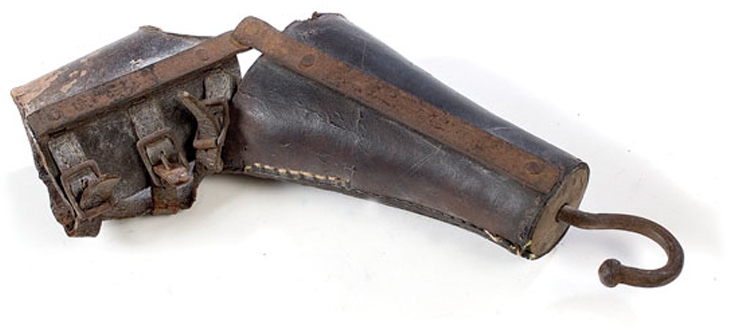The Civil War and the Birth of the U.S. Prosthetics Industry
The Civil War and the Birth of the U.S. Prosthetics Industry


A mid-19th century prosthetic arm made of leather, wood, and iron.
Image courtesy of Cowan’s Auctions.
Date updated: October 23, 2024
The nation’s veterans hospitals regularly care for service members in need of prosthetics or orthotics. And although the magnitude of their injuries is often heartbreaking, it is also inspiring to see how far modern prosthetics technology has come in its ability to restore mobility, dignity, and hope.
The connection between armed conflict and major advances in medical device engineering is hardly new. In fact, it stretches back more than 160 years to the start of the U.S. Civil War, the brutality of which spawned a revolution in the design and mass production of artificial limbs.
Many of the prosthetic technologies helping today's combat veterans owe their existence to innovations and federal programs dating back to this tumultuous period of American history.
Although designers were producing artificial body parts as early as the 1500s, the field did not advance significantly until the spike in demand in the 1860s. The key drivers of progress: deadlier bullets and government money.
Maximum Damage with the Minié Ball
Then, as now, advances in weaponry fueled advances in medical technology. The introduction of the Minié (or Minnie) ball, one of the first practical rifle bullets, was a transformative event in the history of prosthetics. The Minié was made of soft lead with a hollow base that expanded when fired. Upon impact, the bullet caused large, irregular, and slow-healing wounds.
Most physicians of the era were woefully inexperienced in surgery, and were no match for the devastating injuries that these powerful new weapons inflicted. With some 70% of Civil War wounds affecting the limbs, amputation quickly became the treatment of choice in battlefield surgery.
A primary amputation was easier, faster, and—with a mortality rate of “only” 28%—safer than other treatment options. More than 30,000 Union soldiers and 40,000 Confederate soldiers lost limbs between 1861 and 1865, said Robert Gailey, Ph.D., P.T., a professor of physical therapy at the University of Miami School of Medicine and a researcher at the Miami VA Medical Center.
This prosthetic leg was found in Woodhull, Illinois. The sculptural leg is made of hand-carved wood, leather, and hand-forged iron and zinc.
The Great Civil War Benefaction
Recognizing the alarming number of amputations resulting from combat, the U.S. government unveiled the “Great Civil War Benefaction,” a commitment to provide prosthetics to all disabled veterans.
With the lure of government support, entrepreneurs began competing for a share of the growing prosthetics market. This new “arms race” was characterized by far-fetched advertising claims about the comfort and utility of the latest artificial limb, Gailey said.
In fact, few available devices were comfortable and most veterans found crutches to be a better alternative, he said.
Wood and steel were the materials of choice for replacement limbs until about 1863, with the introduction of the cosmetic rubber hand. Rubber offered an attractive alternative to rigid materials in terms of its resiliency, flexibility, and somewhat more natural appearance. Early models featured fingers that could move under pressure, with enough lifelike action to hold small objects like a fork or pencil. For added utility, some models allowed the wearer to remove the cosmetic appendage from the forearm harness and replace it, Swiss Army knife-style, with various hooks, brushes, sawing attachments, or other accessories.
Birth of an Industry
The person who launched the era of modern prosthetics was also the first documented amputee of the Civil War—Confederate soldier James Edward Hanger. Hanger, who lost his leg above the knee to a cannonball, was first fitted with a wooden peg leg by Yankee surgeons. Unhappy with the cumbersome appendage, Hanger eventually designed and built a new, lightweight leg from whittled barrel staves. Hanger’s innovative leg had hinges at the knee and foot, which helped him to sit more comfortably and to walk with a more natural gait. Hangar won the contract to make limbs for Confederate veterans. The company he founded, Hanger, Inc., remains a key player in prosthetics and orthotics today.
The Civil War set the prosthetics industry on a course from wooden legs and simple hooks to today’s quasi-bionic limbs that look like the real thing and can often perform complex tasks. And the commitment to support veterans continues through programs of the VA and the Defense Advanced Research Projects Agency (DARPA) to ensure ongoing progress in prosthetics design.
Fortunately, modern veterans and other amputees have a wide array of advanced prosthetics to help them regain much of their original mobility—and in many cases, their original appearance. From robotic arms that respond to movement impulses from the brain to marathon-tested carbon-fiber prosthetic legs, today’s artificial limbs are restoring independence, productivity, and dignity to severely wounded veterans.
Michael MacRae is an independent journalist.





